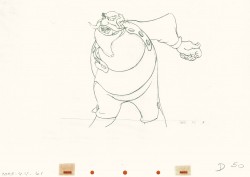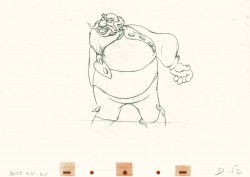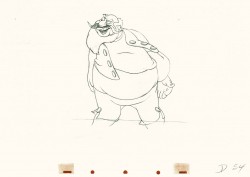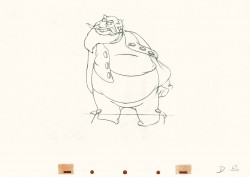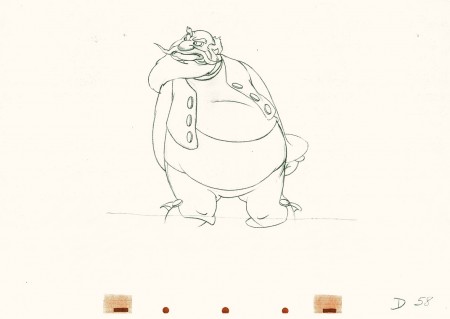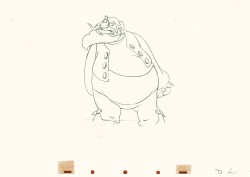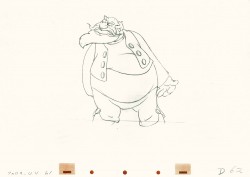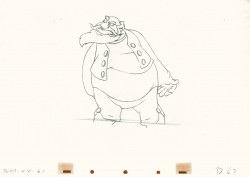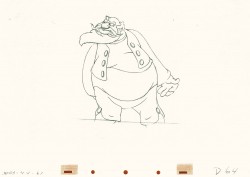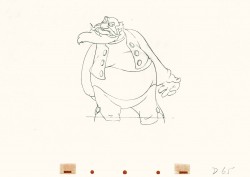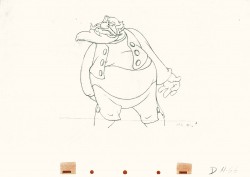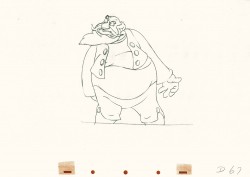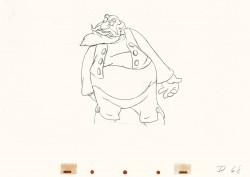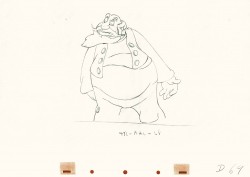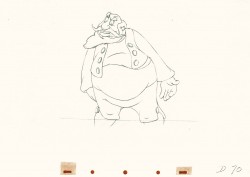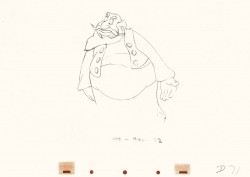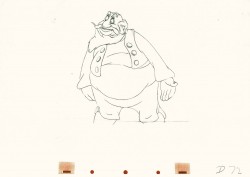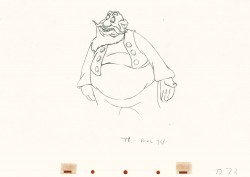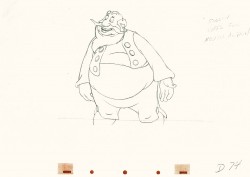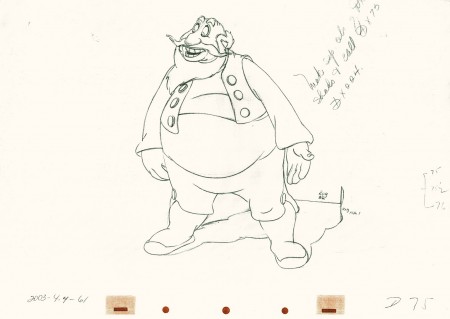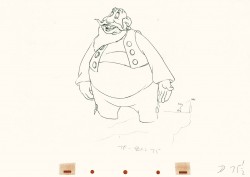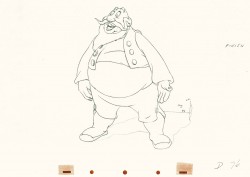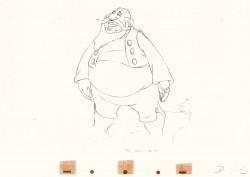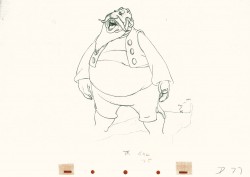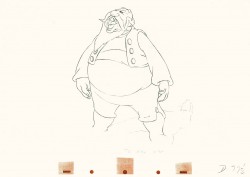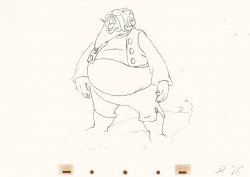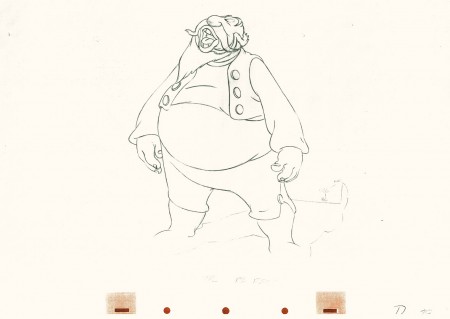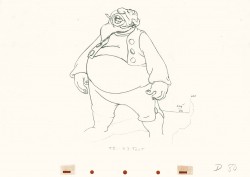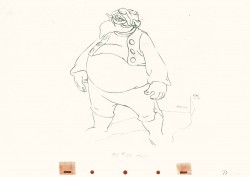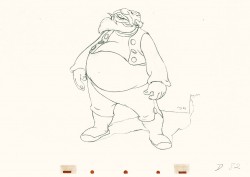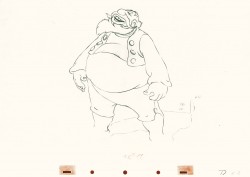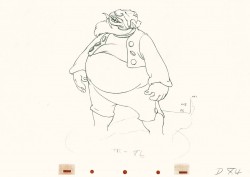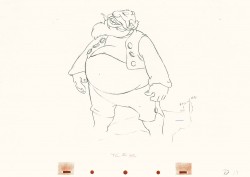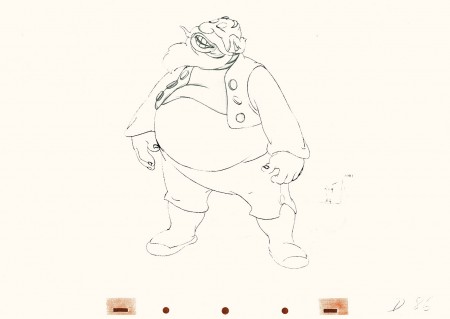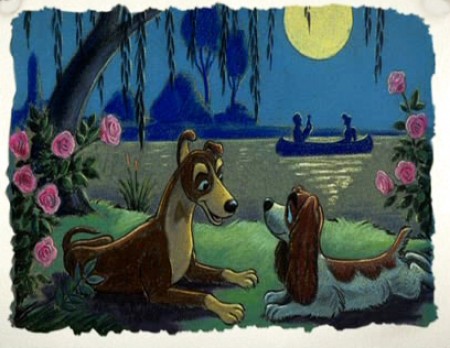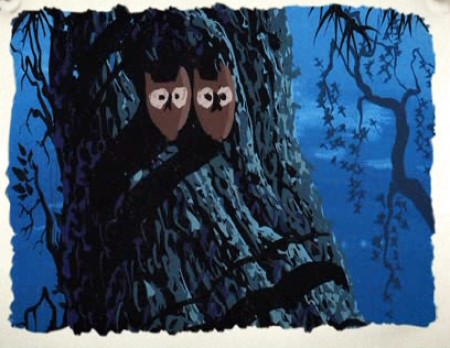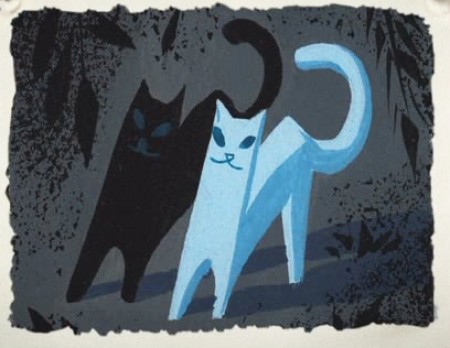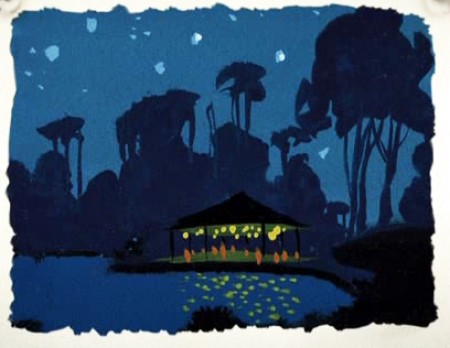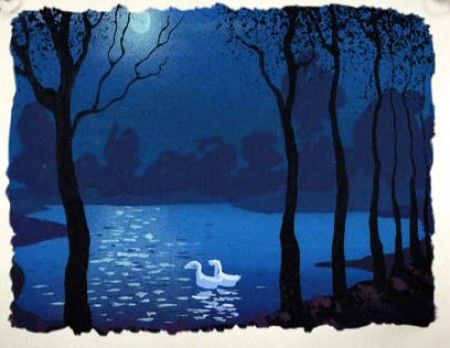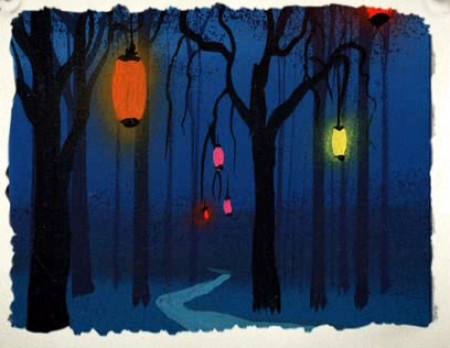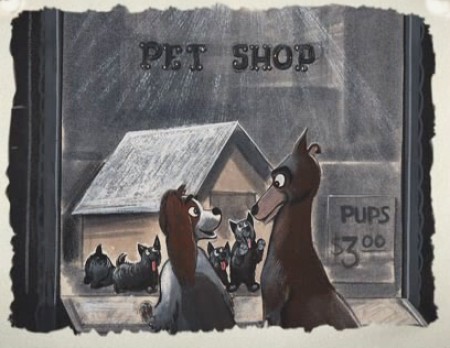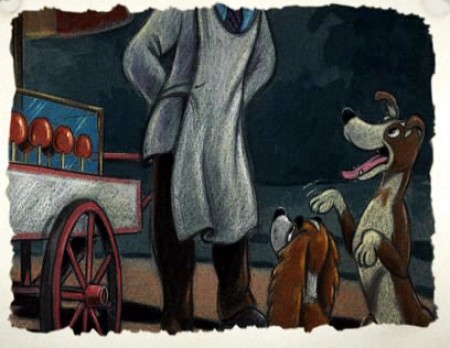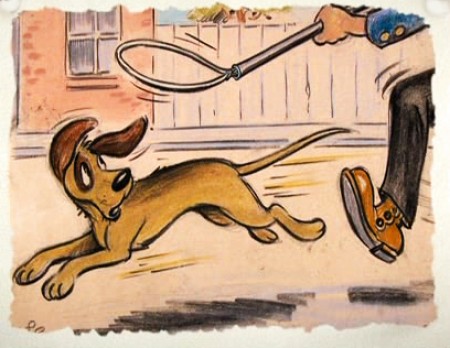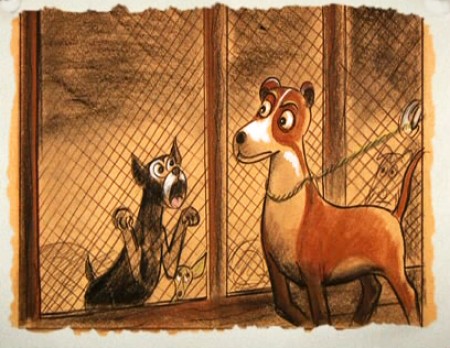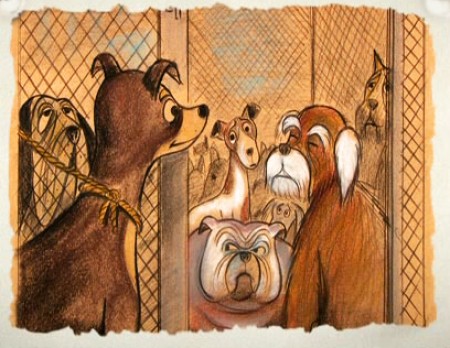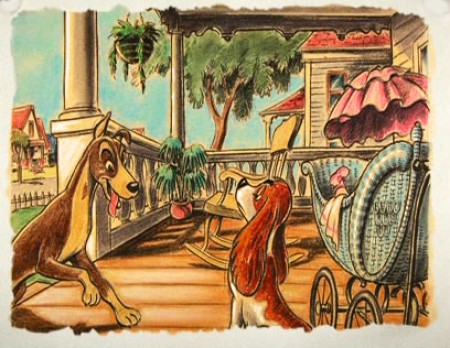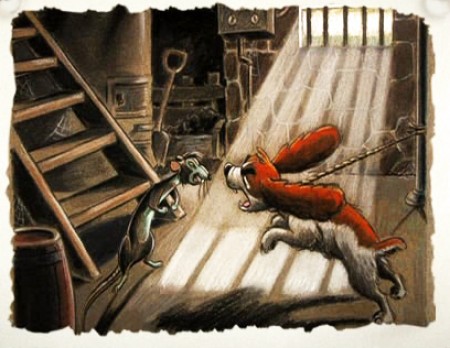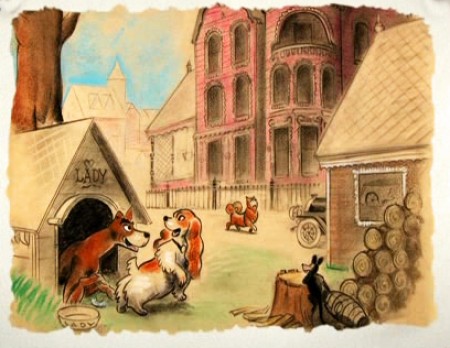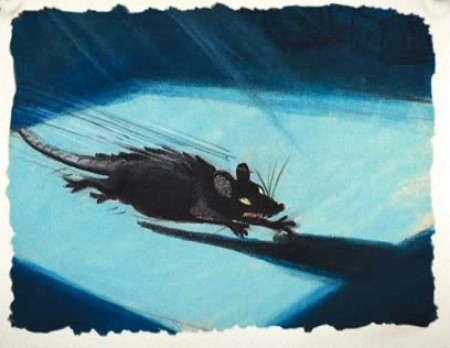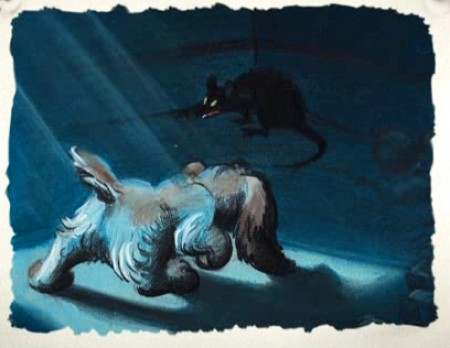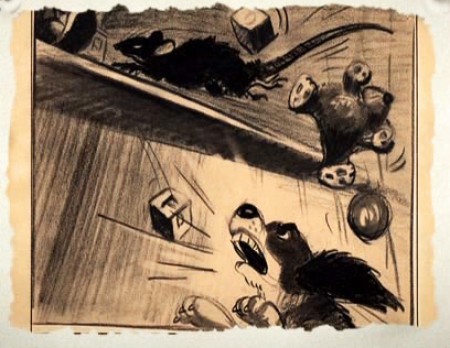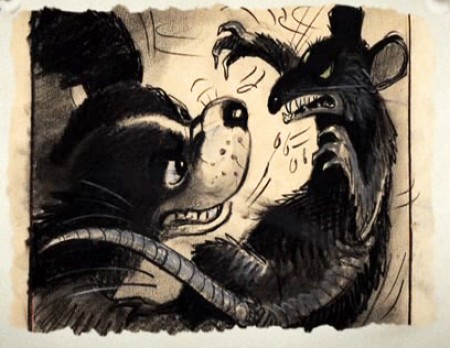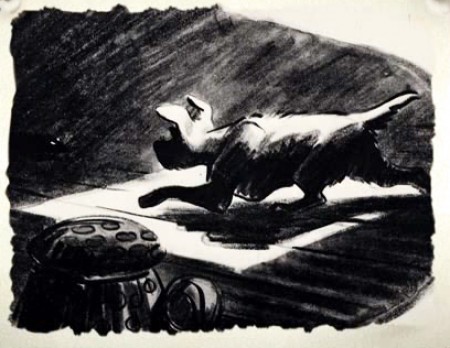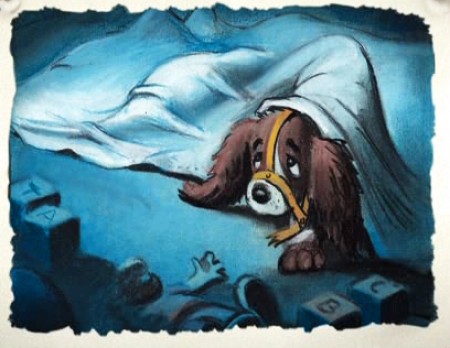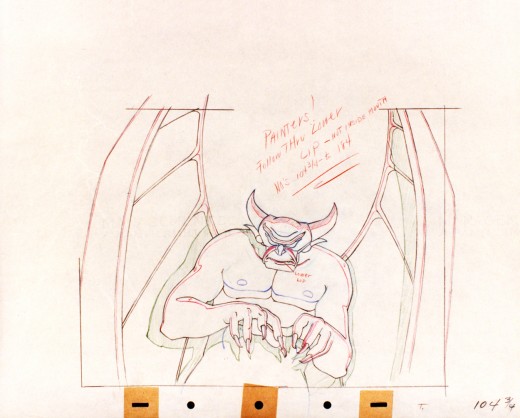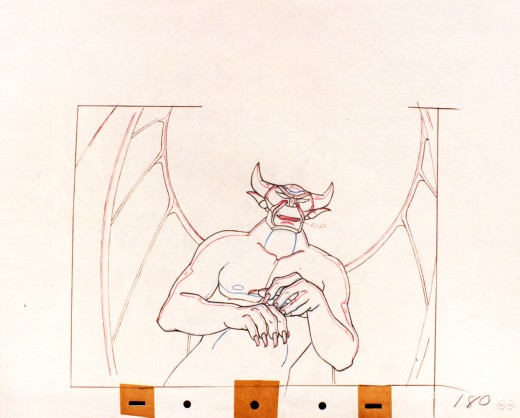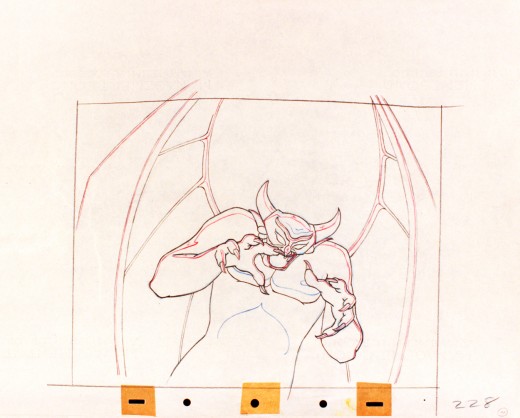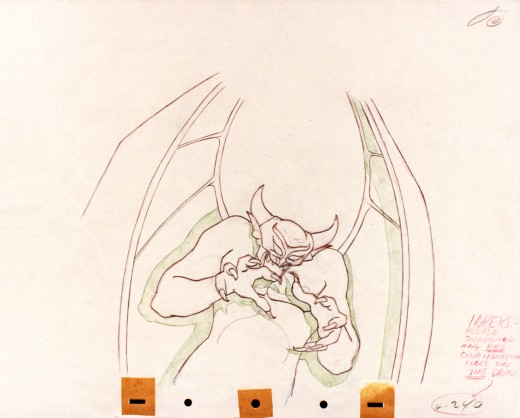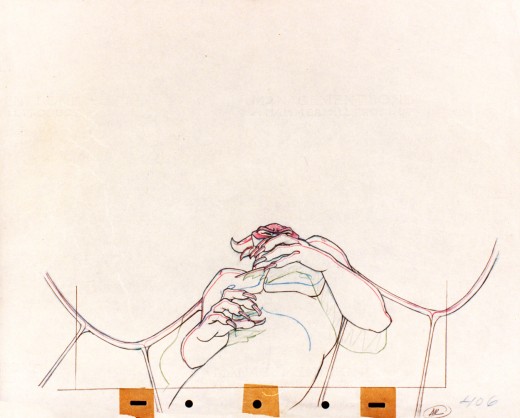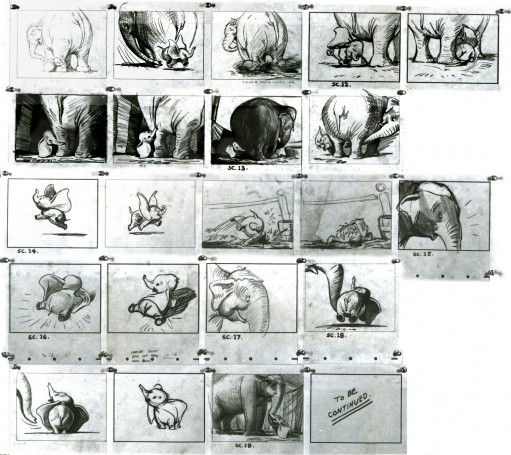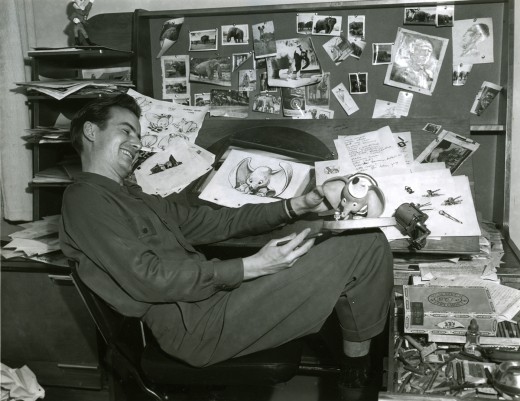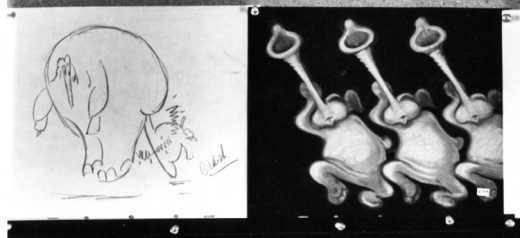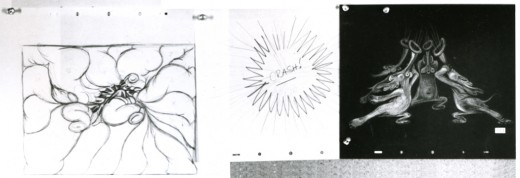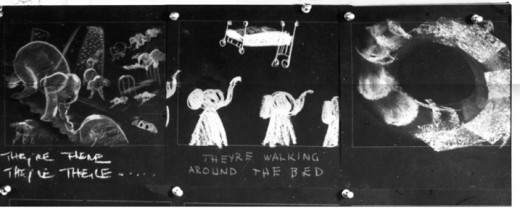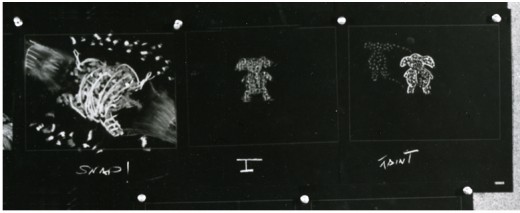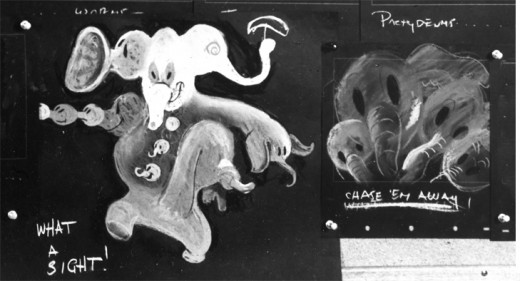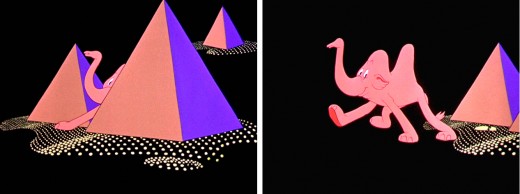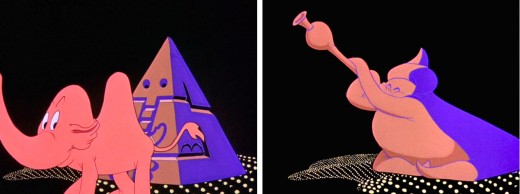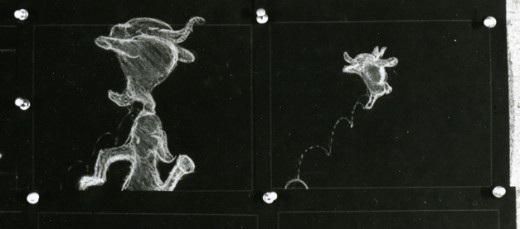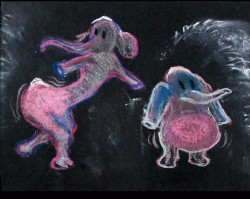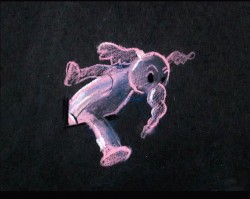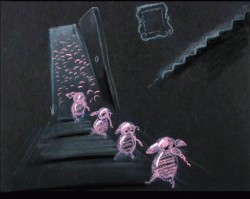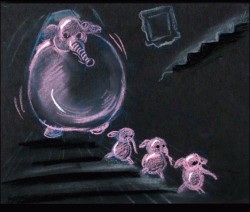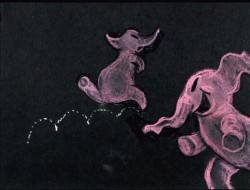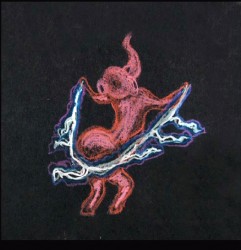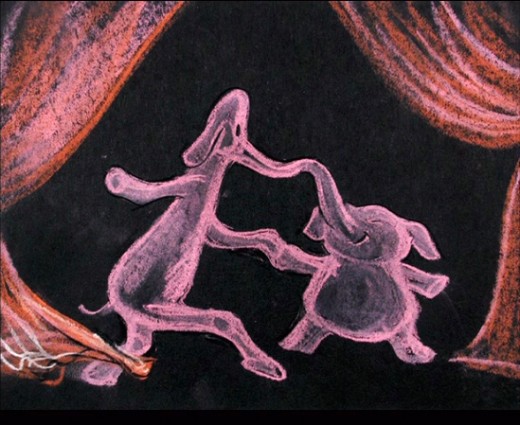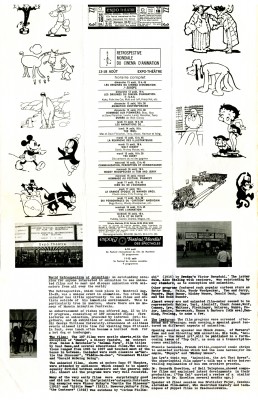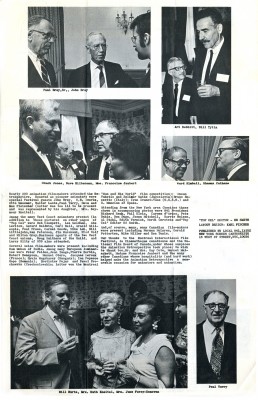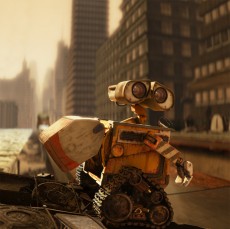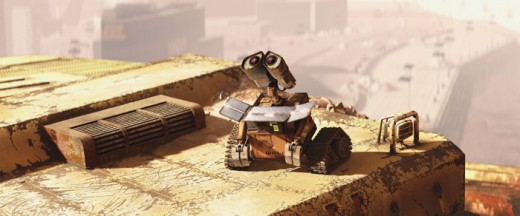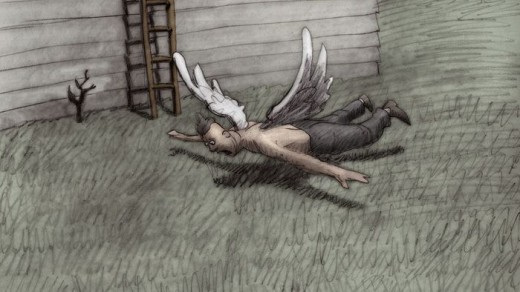Search ResultsFor "dumbo"
Animation &Animation Artifacts &Disney 10 Jun 2009 07:34 am
Tytla’s Stromboli 2
This note arrived from Borge Ring after my first post Bill Tytla’s scene featuring Stromboli’s mood swing:
- The Arch devotees of Milt Kahl have tearfull misgivings about Wladimir Tytla’s magnificent language of distortions. ‘”Yes, he IS good. But he has made SO many ugly drawings”
Musicologists will know that Beethoven abhorred the music of Johan Sebastian Bach.
yukyuk
Børge
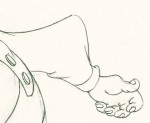
My first post spoke a bit about the distortion Tytla would use to his advantage to get an emotional gesture across. It’s part of the “animating forces instead of forms†method that Tytla used. This is found in Stromboli’s face in the first post. In this one look for this arm in drawing #50. It barely registers but gives strength to the arm move before it as his blouse follows through in extreme.
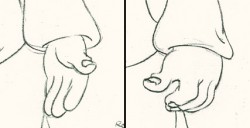 There’s also some beautiful and simple drawing throughout this piece. Stromboli is, basically, a cartoon character that caricatures reality beautifully. A predecessor to Cruella de Vil. In drawings 76 to 80 there’s a simple turn of the hand that is nicely done by some assistant. A little thing among so much bravura animation.
There’s also some beautiful and simple drawing throughout this piece. Stromboli is, basically, a cartoon character that caricatures reality beautifully. A predecessor to Cruella de Vil. In drawings 76 to 80 there’s a simple turn of the hand that is nicely done by some assistant. A little thing among so much bravura animation.
Many people don’t like the exaggerated motion of Stromboli. However, I think it’s perfectly right for the character. He’s Italian – prone to big movements. He’s a performer who, like many actors in real life, goes for the big gesture. In short his character is all there – garlic breath and all. It’s not cliched and it’s well felt and thought out. Think of the Devil in “Night on Bald Mountain” that would follow, then the simply wonderful and understated Dumbo who would follow that. Tytla was a versatile master.
Here’s part 2 of the scene:
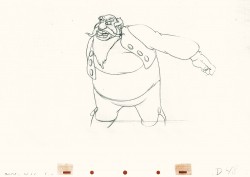 48
48 49
49(Click any image to enlarge.) The full scene with all drawings.
Click left side of the black bar to play.
Right side to watch single frame.
Animation Artifacts &Disney &Frame Grabs &Story & Storyboards 01 May 2009 07:33 am
Even More Lady drawings
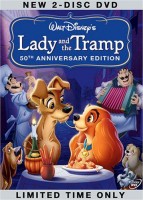 - I’ve been posting frame grabs from the recent DVD of Disney’s Lady and the Tramp. Unfortunately, they give these in such a small form that it’s hard to view them on the tv screen. Hopefully, this will give a better opportunity of seeing some of this artwork.
- I’ve been posting frame grabs from the recent DVD of Disney’s Lady and the Tramp. Unfortunately, they give these in such a small form that it’s hard to view them on the tv screen. Hopefully, this will give a better opportunity of seeing some of this artwork.
I have a couple of other small comments about these DVD’s in release today. Aside from the annoyance of these gallery drawings being offered at such a diminished size so that you can’t really study any of them, there’s also the problem that the artwork is not labelled in any way. God forbid they should promote the name of anyone who painted these images.
There’s also no commentary track anymore. If you go back to the not-very-special version of Dumbo, there’s one of the all-time-great commentary tracks. John Canemaker did it by himself, and by the time you get well into the film, you realize the depth of information you’re getting from John even though his relaxed and natural voice charms you. I have to say I’ve listened to this commentary four or five times.
There are plenty of other problems I have with these new “Special” productions that I won’t get into; regardless, here are the images I could get.
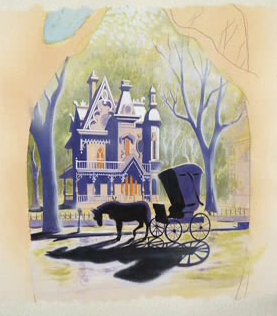
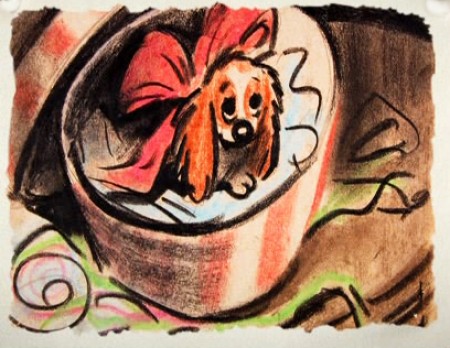
I’d say that you could enlarge the images if you clicked on them,
but unfortunately I’m even enlarging some of them with these thumbnails.
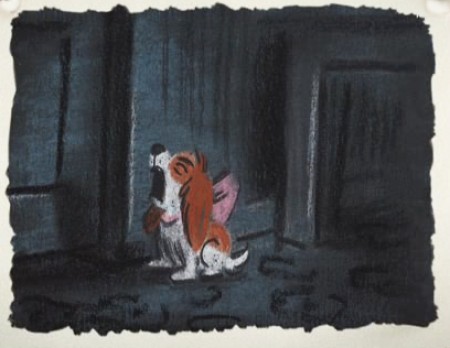
They’re such beautiful drawings/paintings to produce at so small a size.
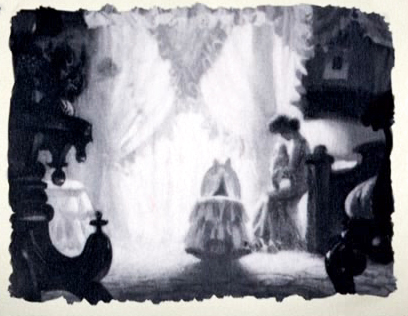
.
Commentary 03 Apr 2009 07:54 am
Banjo plucking
- Michael Barrier responded negatively to my comments on Don Bluth’s Banjo the Woodpile Cat. I thought to write a letter to Mike in comment, but decided it’d be more fun for me to post my response to his response here.
Let me break this down into two parts. The first addresses the funding of new animated projects.
- In my post, I said, “My only sadness is that the Bluth studio isn’t moving forward with more features . . . I wish he could engender the cash to continue on with the medium.”
To that, Mike said, “I couldn’t disagree more. Bluth is for me a white-bread Ralph Bakshi, someone who sucked up money that should have gone to other people, then used it to make terrible features that tanked at the box office and ultimately made it more difficult for good films to get made. If Bluth is finally on the sidelines, that’s cause for rejoicing. I hope he stays there.”
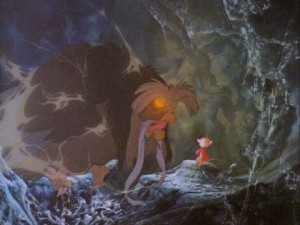 There’s an old saying within film circles: Any publicity is good publicity. That means getting a lashing from the critics is, in many ways, just as good as getting a rave. The idea is to get your name out there and to be noticed.
There’s an old saying within film circles: Any publicity is good publicity. That means getting a lashing from the critics is, in many ways, just as good as getting a rave. The idea is to get your name out there and to be noticed.
The same, in my mind, goes for animated films. The more the merrier. Just because a film or three fails doesn’t mean financing will dry up for everyone. Despite the obvious thought behind it, that’s a logic 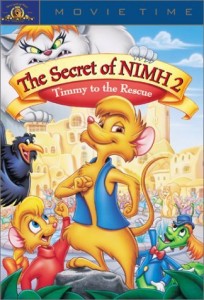 that has no real bearing on what happens within the film industry. There being a small number of animated features is what makes it more difficult. When a type of film is a rarity, it’s unlikely money people are going to trust another with their money. Make animated features commonplace, and it’s more likely money will come. As a matter of fact, another dozen features would make things easier.
that has no real bearing on what happens within the film industry. There being a small number of animated features is what makes it more difficult. When a type of film is a rarity, it’s unlikely money people are going to trust another with their money. Make animated features commonplace, and it’s more likely money will come. As a matter of fact, another dozen features would make things easier.
Given the state of 2D feature animation today, a Bluth film would be a gem in comparison to what’s out there. Somehow I can’t pin my hopes on Bye-Bye Bin Laden, now showing at the South Beach Film Festival. Who knows? Maybe it’s good, but for some reason my expectations aren’t high. It’s obviously a flash film chock full of stupid jokes, but it’ll do nothing to advance the medium AT ALL. Don Bluth’s attempt to do full and high character animation will advance it – if only to develop new and trained animators.
After Titan AE, the Bluth studio closed, but Fox turned to others that they’d used to help finish the film. That studio became what is today Blue Sky, employing lots of cg animators doing markedly different work from those on the West coast. To me that was a positive (regardless of whether I like Bluth OR Blue Sky.) There’s another studio out there generating lots of money for animated films.
Does it help the medium? If you’re just talking about getting more animation funded, then yes it does. Maybe one of these films will be good.
The second point has to do with what furthers the medium as far as quality is concerned.
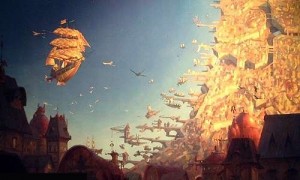 This is a tough one to respond to considering how negative I am toward most current animation.
This is a tough one to respond to considering how negative I am toward most current animation.
As opposed to the days when Don Bluth made Anastasia and Disney did Treasure Planet, we’re now living in an age of cgi animation. The best Hollywood theatrical features are predominantly cg.
Madagascar 6, Toy Story 5, Shrek 12, and Ice Age 9 aren’t going to advance the medium any more than that original Toy Story did. That film showed executives who originally didn’t even invest in collateral marketing (no dolls, no Woody Big Macs, no coloring books), that they could make a bundle from this new medium. They’d made an error in not supporting that film and had to make amends. Once you had the characters rigged, how easy it would be to do follow up films. Why waste time drawing all those cows for Home on the Range. Nickelodeon jumped in with Barnyard‘s ugly cg cows that were horrible in the film and no better in the series. But hey, they made money. Isn’t that what it’s all about?
Sorry Mike, gone FOREVER are the days of Snow White and Dumbo. Cinderella and Alice in Wonderland are gone. Even 101 Dalmatians and Jungle Book are gone. Hell, even Hunchback of Notre Dame and Treasure Planet are gone.
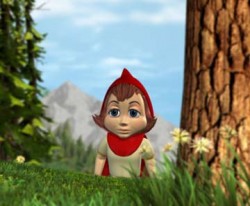 Today’s features are Hoodwinked and Delgo, Roadside Romeo and Space Chimps, TMNT and Valiant. Had enough or should I mention Everyone’s Hero and Igor?
Today’s features are Hoodwinked and Delgo, Roadside Romeo and Space Chimps, TMNT and Valiant. Had enough or should I mention Everyone’s Hero and Igor?
Happy Feet and Bolt were nominated for Oscars. So was Jimmy Neutron. The medium isn’t even medium any more; it’s in minor mode. Dreamworks is on automatic pilot with their rowdy movies; Disney is trying to find itself, and Pixar keeps thinking they’re pushing the envelope. I know, let’s put it in 3D so they can charge more and promote a higher opening gross!
If we’re just talking in the abstract, you’re right. The soft animation in the Bluth films is not good animation. But in reality is it any worse than the last half dozen 2D features you saw? Should someone who literally, like the “white bread Bakshi,” kept the medium alive in a fallow period of The Black Cauldron and Basil of Baker Street? We no longer have Milt Kahl, John Lounsbery or Frank Thomas. No Hal Ambro, John Sibley or a dozen other greats to animate the featurees. John Pomeroy and other younger animators are what we have today, and constructive criticism might help turn their styles a bit. Saying they shouldn’t work again is kind of crazy.
Independent animation may be the place to watch. The only hope isn’t in the development of the character movement but the development of the themes. The flash animated (meaning limited animation) Waltz with Bashir made headlines and a little money; the flash animated Sita Sings the Blues (which couldn’t even get a release) gathered the attention and showed what could be done with a story. Persepolis was a bit fuller animation, but the story was the film. No improvement in animation technique, but good words for animated films. Bill Plympton has been producing features for years. There’s some real and personal animation in there, even if I’m not the ideal audience for his films. And don’t forget The Triplettes of Belleville. They really tried something AND made some money for their low budget effort.
There’s hope, but not much. No studio is doing anything of note with 2D animation, and the medium isn’t growing except in the hearts of a handful. CG is in the early stages of developement, and who knows where they’ll land.
I was all over the place, and I don’t think I completely answered Mike’s thoughts. I do know I disagree with what he’s saying in his recent post. I usually agree with what he has to say. I agree with that review of Treasure Planet, for example. However when he tells me that someone with the background of Don Bluth shouldn’t be making more films I can’t agree. When he says The Polar Express is good, I have to disagree. All I can see is that it inspires lazy film makers like Robert Zemeckis to do more. Beowulf anybody? How about Jim Carrey in The Christmas Carol? Yet I won’t say Zemeckis should stop making movies, because I know he’ll get the ball rolling for a few more. Maybe one of them will be good.
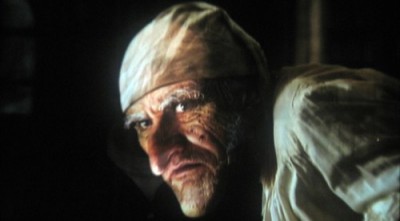
Where’s Mr. Magoo when you need him?
Articles on Animation &Disney 14 Mar 2009 08:12 am
After Walt
- Didier Ghez on his site Disney History recently posted an article about life at the Disney Studio after Walt’s death in 1966. There were quite a few such articles during this period, and we were made to hope something would happen to generate life into the animation division of a company that was turning out bad films.
Time Magazine had the following article in their Aug. 16, 1979 issue:
CORPORATIONS
Running Disney Walt’s Way
When lung cancer killed Walt Elias Disney a decade ago, there were fears that the world of Disney would lose some of its wonder—and its profits. But before his own death in 1971, Roy Disney, who succeeded his younger brother, and a cadre of post-Walt executives had turned Walt Disney Productions into a thriving empire of fantasy. Today the company is bigger and richer than ever. Profits flow in from Disney’s two successful theme parks, Disneyland in California and the magic kingdom at Walt Disney World in Florida, from film rentals and television, from re-releases of such longtime favorites as Bambi, Pi-nocchio and Fantasia, and from sales of record albums, Mickey Mouse wrist-watches and everything else bearing the Disney stamp.
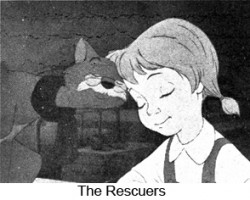 Last year the various forms of escapism earned Disney nearly $62 million on sales of $520 million—four times the total in 1966 when Walt died. For the first nine months of its current fiscal year, Disney was flying higher than Dumbo the elephant. Corporate profits were up 30%, and sales rose 16%. More than 6 million people flocked to Disneyland (which turned 21 in July), another 9 million to Disney World. The fifth re-release of the animated Snow White and the Seven Dwarfs, which came out in 1937, will gross an estimated $10 million in the U.S. alone by the end of this year.
Last year the various forms of escapism earned Disney nearly $62 million on sales of $520 million—four times the total in 1966 when Walt died. For the first nine months of its current fiscal year, Disney was flying higher than Dumbo the elephant. Corporate profits were up 30%, and sales rose 16%. More than 6 million people flocked to Disneyland (which turned 21 in July), another 9 million to Disney World. The fifth re-release of the animated Snow White and the Seven Dwarfs, which came out in 1937, will gross an estimated $10 million in the U.S. alone by the end of this year.
Analysts’ View. No one questions that Disney has come a long way since the studio gambled $1.5 million on Snow White. But Wall Street analysts insist that the company should be doing even better and are hypersensitive to any developments that could remotely be considered adverse. Last month, for example, Disney stock fell several points (to around $50, or more than 20 times earnings) because third-quarter earnings, though a record $19 million, were not up to Wall Street’s expectations. Says a Disney vice president: “That’s a source of irritation around here. They seem to run in a pack on the Street.”
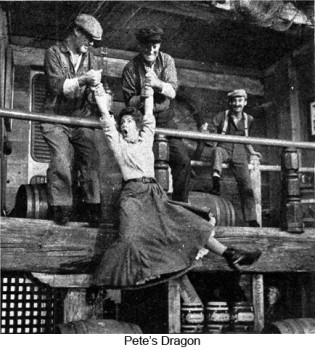 The founder’s ideas still run the show: almost everything Disney is now into was conceived of by Walt. “That’s the way Walt would want it” is a refrain heard frequently in the stucco Disney headquarters in Burbank, Calif. The executive most responsible for sticking to Walt’s winning formulas is E. Car-don Walker, 60, who joined Walt as a camera operator in the 1930s and has been Disney president since 1971. A tall, husky man whose use of profanity is limited to an occasional G-rated “damn,” Card Walker occupies an unpretentious office on the Disney lot not far from Dopey Drive and Mickey Avenue. His only concessions to the Hollywood movie mogul image are tinted glasses and a sleek gray Porsche (license plate: CAR WIN).
The founder’s ideas still run the show: almost everything Disney is now into was conceived of by Walt. “That’s the way Walt would want it” is a refrain heard frequently in the stucco Disney headquarters in Burbank, Calif. The executive most responsible for sticking to Walt’s winning formulas is E. Car-don Walker, 60, who joined Walt as a camera operator in the 1930s and has been Disney president since 1971. A tall, husky man whose use of profanity is limited to an occasional G-rated “damn,” Card Walker occupies an unpretentious office on the Disney lot not far from Dopey Drive and Mickey Avenue. His only concessions to the Hollywood movie mogul image are tinted glasses and a sleek gray Porsche (license plate: CAR WIN).
Walker believes that “the biggest challenge we face is still to make top-quality films,” and film critics tend to agree. Though slick and successful, the recent crop of Disney animated and live-action films (Gus, Treasure of Mate-cumbe, Robin Hood) shows little of Walt’s skill at tugging an audience over pop-emotional peaks and valleys. Nor do the forthcoming The Rescuers and Pete’s Dragon. Indeed, not since Mary Poppins in 1964 has Disney produced a genuinely smashing, supercalifragilisti-cexpialidocious hit.
This fact troubles Walt’s corporate heirs. Says Walker: “I don’t know exactly what it is. We don’t cut costs. Based on the quality of people involved in the film making, I would just have to say that we do our best.” Others blame excessive reverence for the traditional Disney method of moviemaking: batteries of cartoonists working under a rigid discipline on a single project for as long as three years. Says one young artist-animator who worked briefly for Disney: “The work is too confining. There’s not enough room to use your creative talents. It’s sterile.”
More and more, Disney is setting its animators to work on gutsier movies that seize audiences instead of rocking them to sleep. One feature in the storyboard stage, The Hero from Otherwhere, is about two schoolboys who find themselves on a strange planet whose black leader persuades them to help destroy a wolf that has been ravaging the land. Another, Spacecraft One, about a mile-long spaceship in its search for life on other planets, is Disney’s most elaborate sci-fi undertaking since 20,000 Leagues Under the Sea. The Black Cauldron, still in the treatment-writing stages, is about a pig keeper’s struggle with a villain whose shtick is regenerating an army of warriors from dead bodies—a long way from Poppins. Sex and excessive violence still are taboo on the Disney lot, but Walker foresees increased sophistication as younger animators reflect contemporary themes.
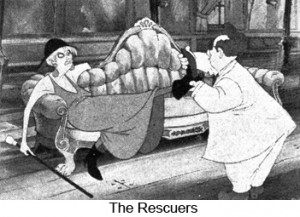 Non-film projects, however, account for three-fourths of Disney revenues and therefore generate the greatest excitement in the Disney organization. With Disneyland and Walt Disney World booming, the company is now moving on the biggest of Walt’s ideas: EPCOT, or Experimental Prototype Community of Tomorrow. To be built by the early 1980s in Florida as an expansion of Disney World, EPCOT will be a living laboratory of applied technology in transportation, housing, communications and waste disposal. Near it will rise the World Showcase, a permanent World’s Fair. Still another theme park. Oriental Disneyland, now planned to open late in 1979, will border Tokyo Bay in Japan; the Disney people expect it to draw 10 million visitors annually at the tourist hub of Asia. Estimated cost: about $175 million—most to be borne by the Japanese.
Non-film projects, however, account for three-fourths of Disney revenues and therefore generate the greatest excitement in the Disney organization. With Disneyland and Walt Disney World booming, the company is now moving on the biggest of Walt’s ideas: EPCOT, or Experimental Prototype Community of Tomorrow. To be built by the early 1980s in Florida as an expansion of Disney World, EPCOT will be a living laboratory of applied technology in transportation, housing, communications and waste disposal. Near it will rise the World Showcase, a permanent World’s Fair. Still another theme park. Oriental Disneyland, now planned to open late in 1979, will border Tokyo Bay in Japan; the Disney people expect it to draw 10 million visitors annually at the tourist hub of Asia. Estimated cost: about $175 million—most to be borne by the Japanese.
Double Duty. Whatever its problems, Disney has perfected one talent that other Hollywood fantasy factories envy: piggybacking. The familiar cartoon characters boost attendance at the theme parks, and the parks increase attendance at the movies. Though no one at Disney claims to be Walt’s equal in artistry or dreaming, Card Walker has made Disney’s characters do double duty as stars and as barkers to all the world. As a merchandising idea, it has proved to be almost as successful an inspiration as the original Mickey Mouse.
Animation &Disney 09 Feb 2009 09:20 am
Devils
- The BAFTAs were doled out last night. Slumdog Mullinaire won everything it was eligible for. Fortunately it wasn’t in the Short animation category. That was won by WALLACE AND GROMIT: A MATTER OF LOAF AND DEATH – Steve Pegram, Nick Park, Bob Baker.
Wall-E beat out Persepolis and Waltz with Bashir (great nominees) for Best Feature.
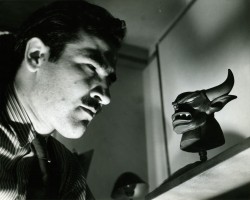 - Going under the assumption that there never are enough of Tytla’s Devils on the internet, I’ve got a few drawings to show here.
- Going under the assumption that there never are enough of Tytla’s Devils on the internet, I’ve got a few drawings to show here.
These were photographs of drawings taken (rather dark exposure that I lightened a bit) of what appears to be some cleanups. Most of them are from one scene; one drawing is from another. They’re all treasures.
How do you go from delicate Dumbo’s bath to this? That’s acting!
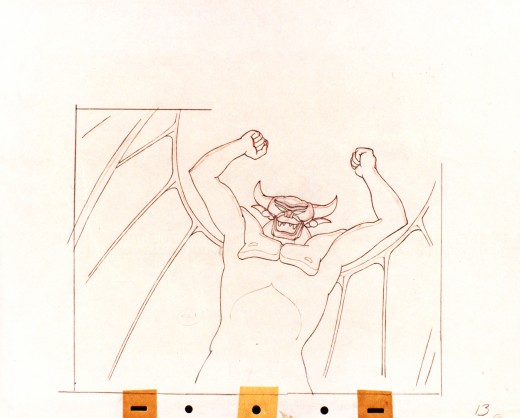
(Click any image to enlarge.)
Animation &Animation Artifacts &Disney &Story & Storyboards 06 Feb 2009 08:58 am
Recap: Dumbo’s bath
Here’s a recap of a couple of past posts I’d made showing one of my favorite sequences in animation – Dumbo’s bath and play with his mother.
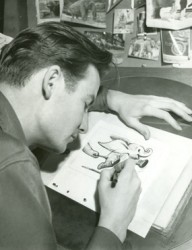 - Thanks to a loan from John Canemaker, I can continue posting some of the brilliant storyboard work of Bill Peet. The guy was a masterful artist. Every panel gives so much inspiration and information to the animators, directors and artists who’ll follow up on his work.
- Thanks to a loan from John Canemaker, I can continue posting some of the brilliant storyboard work of Bill Peet. The guy was a masterful artist. Every panel gives so much inspiration and information to the animators, directors and artists who’ll follow up on his work.
This is the sequence from Dumbo wherein baby Dumbo plays around the feet of his mother. Brilliantly animated by Bill Tytla, this sequence is one of the greatest ever animated. No rotoscoping, no MoCap. Just brilliant artists collaborating with perfect timing, perfect structure, perfect everything. Tytla said he watched his young son at home to learn how to animate Dumbo. Bill Peet told Mike Barrier that he was a big fan of circuses, so he was delighted to be working on this piece. Both used their excitement and enthusiasm to bring something brilliant to the screen, and it stands as a masterpiece of the medium.
Of this sequence and Tytla’s animation, Mike Barrier says in Hollywood Cartoons, “What might otherwise be mere cuteness acquires poignance because it is always shaded by a parent’s knowledge of pain and risk. If Dumbo “acted” more, he would almost certainly be a less successful character—’cuter,’ probably, in the cookie-cutter manner of so many other animated characters, but far more superficial.”
I had to take the one very long photstat and reconfigure it in photoshop so that you could enlarge these frames to see them well. I tried to keep the feel of these drawings pinned to that board in tact.
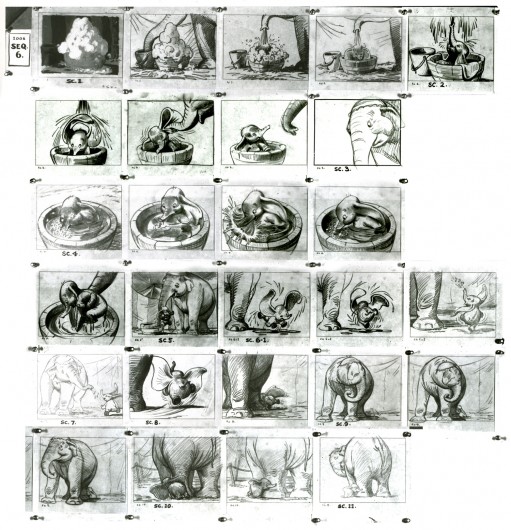
(Click any image to enlarge.)
Here are frame grabs from the very same sequence of the film showing how closely the cuts were followed. Even in stills the sequence is stunning.

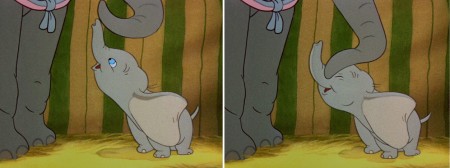
(Click any image to enlarge.)
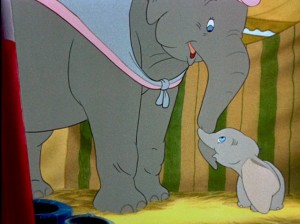
This film is a gem.
The dvd also has one of my favorite commentary tracks throughout.
John Canemaker, by himself, talking about the film. It’s great.
Animation Artifacts &Disney &Peet &repeated posts &Story & Storyboards 26 Nov 2008 09:35 am
Recap – Pink Elephants
- Recently, I saw a small part of Aladdin on television. A large part of the Genie’s song reminded me of Pink Elephants from Dumbo. I thought then, that I should post anew the models/sketches and drawings from that sequence. It originally was broken in two parts when it saw daylight here in 2007. I’ve combined there into one.
Once again, thanks to John Canemaker, I have several photo images to display. Some frame grabs accompany the piece.
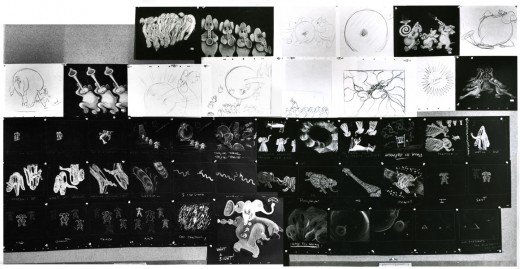
These are rather small images, so by cutting up the large boards and reassembling them I can post them at a higher resolution, making them better seen when clicking each image. It’ll take two days to post them all, so this will be continued later this week.
I’ve interspersed some frame grabs fromt the sequence to give an idea of the coloring.
The following images were in the gallery part of the dvd. These are the color versions of some of the images above.
Festivals &repeated posts 01 Oct 2008 08:04 am
Montreal revisited
- Having been to the Ottawa Animation Festival last week, I thought back to the great grandparent of this Festival. Back in 1967 there was a world gathering of animators at the Montreal World Fair which set the stage for all other North American Festivals. Here’s a repeat of the program I posted back in 2006.
This was a special issue of Top Cel, the NY animation guild’s newspaper. Dated August 1967, it celebrates the Montreal Expo animation conference and exhibition held that summer. Obviously, this was the place to be that year if you were an animation lover.
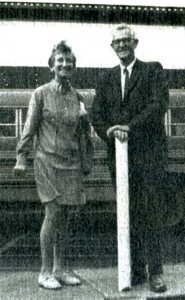 Just take a look at that list of signatures of attendees. Some of them are:
Just take a look at that list of signatures of attendees. Some of them are:
Chuck Jones, Peter Foldes, Manuel Otero, Edith Vernick, Abe Levitow, Don Bajus, Bill & Fini Littlejohn, John Halas, Ward Kimball, Ken Peterson, Shamus Culhane, Carl Bell, Pete Burness, Ub Iwerks, Gerald Baldwin, I. Klein, Gene Plotnick, Ian Popesco-Gopo, Carmen d’Avino, Bill Mathews, Len Lye, June Foray, Bill Hurtz, Spence Peel, Paul Frees, Steve Bosustow, Dave Hilberman, Stan Van der Beek, Les Goldman, Jimmy Murakami, Mike Lah, Robert Breer, Tom Roth, Art Babbitt, Feodor Khitruk, Fred Wolf, Ivan Ivanov-Vano, Paul Terry, J.R. Bray, Walter Lantz, Otto Messmer, Dave Fleischer, Ruth Kneitel, Bruno Bozzetto, Bob Clampett, Karel Zeman, Dusn Vukotic, Bretislav Pojar, Jean Image, Grim Natwick, Tissa David, Barrie Nelson, Andre Martin, Ed Smith, Dick Rauh, and John Whitney.
I guess they don’t make Festivals like they used to. There doesn’t seem to be much written about this event, and I wish some of those in attendance would write about it.
From the Wikepedia entry for Bill Tytla, there’s the John Culhane quote: On August 13, 1967, the opening night of the Montreal Expo’s World Exhibition of Animation Cinema, featured a screening of Dumbo as part of an Hommage Aux Pionniers. Tytla was invited, but worried if anyone would remember him. When the film finished, they announced the presence of “The Great Animator.” When the spotlight finally found him, the audience erupted in “a huge outpouring of love. It may have been one of the great moments of his life,” recalled John Culhane. I’m sure there were many such moments.
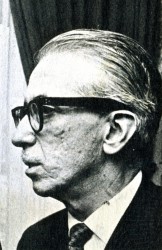 Just to make it all personal, let me tell you a story, although this has nothing to do with Montreal’s Exhibit.
Just to make it all personal, let me tell you a story, although this has nothing to do with Montreal’s Exhibit.
Pepe Ruiz was the union’s business manager. In 1966 – the year prior to this expo – I was a junior in college, determined to break into the animation industry. Of course, I knew the military was coming as soon as I graduated, but I called the union to have a meeting with Pepe. I wanted to see what the likelihood of a “part time job” would be in animation. This took a lot of courage on my part to see what the union was about. I pretty well knew part time jobs didn’t exist. There was no such thing as interns back then.
Pepe was an odd guy who kept calling me “sweetheart” and “darling” and he told me that it was unlikely that I could get something part time in an animation studio.
However he did send me to Terrytoons to check it out.
I met with the production manager, at the time, Nick Alberti. It was obvious I was holding up Mr. Alberti’s exit for a game of golf, but he was kind and said that part time work wasn’t something they did. (He moved on to Technicolor film lab as an expediter after Terry‘s closed. I had contact with him frequently for years later, though I never brought up our meeting and doubt he would have remembered it.) Ultimately, I was pleased to have been inside Terrytoons‘ studio before it shut down shortly thereafter. A little adventure that let me feel as though I was getting closer to the world of animation.
The photos of the Expo are worth a good look. I’ve singled out those above to place around my text. The picture of Tissa and Grim is a nice one of the two of them together.
Ed Smith was the Top Cel editor at the time, and he put together a creative publication.
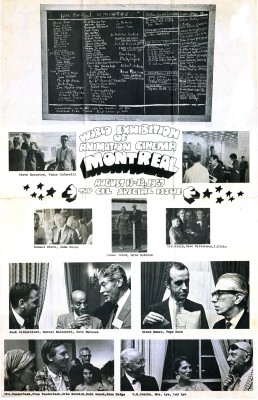 1
1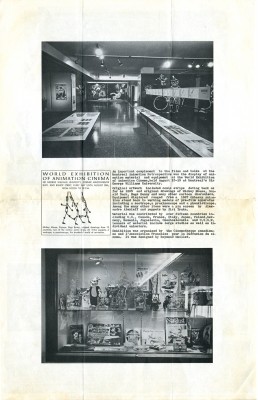 2
2(Click on any image to enlarge.)
Commentary 06 Jul 2008 08:13 am
more or less – 2
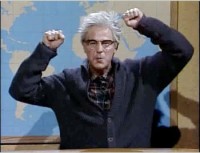 - Dana Carvey, on Saturday Night Live, used to have the “grumpy old man” character. “We had to eat worms, and we liked it!” I’m beginning to feel like the grumpy old man, but I’m hoping I’m saying something here, that touches a nerve in someone else.
- Dana Carvey, on Saturday Night Live, used to have the “grumpy old man” character. “We had to eat worms, and we liked it!” I’m beginning to feel like the grumpy old man, but I’m hoping I’m saying something here, that touches a nerve in someone else.
Yesterday, I was headed in the direction of saying that computer animation in Harry Potter or Lord of the Rings or Indiana Jones 4 was no different to me than the computer animation in Wall-E or, ultimately, Kung Fu Panda. They all move, but, to me, none of them live. The “animus” isn’t there. Artful, well crafted movement is there, but it’s not something that inspires me to go out and draw or get back to my animation box (for the most part, a computer.)
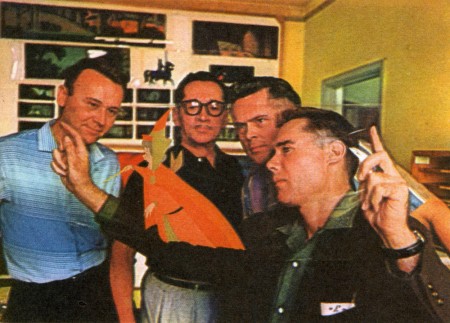 I can remember when just looking at the picture to the right of Eyvind Earle holding up a Sleeping Beauty cel (in Bob Thomas’ book, The Art of Animation) would thrill me to the bone so that I had to start drawing or get myself to the board.
I can remember when just looking at the picture to the right of Eyvind Earle holding up a Sleeping Beauty cel (in Bob Thomas’ book, The Art of Animation) would thrill me to the bone so that I had to start drawing or get myself to the board.
After the release of Beauty and the Beast, John Canemaker and I had a conversation. He pointed out that once he or I would have been taken by a screening of Fantasia or Dumbo and been inspired to animate, and a youngster, today, seeing B and the B would have that same rush. The newer film may not have inspired either of us, but other, younger, future animators were. This was comforting to me.
But recently, when commenting about Wall-E, I wondered if anyone would be inspired by that film. Were there youngsters out there who felt compelled to animate after seeing the Pixar movie? Perhaps through lack of imagination, I can’t see it. But I can’t see it.
Somehow, though, The Iron Giant seemed like something that could inspire people. I also thought The Triplettes of Belleville and Persepolis were inspirational to future animators. I expect the same was true of Toy Story, The Incredibles, even Ratatouille. Perhaps even Kung Fu Panda.
When Don Bluth ran away from Disney and set up his own company to make The Secret of Nimh, there was a lot of excitement in watching their progress. The film wasn’t all we hoped for, but it was light years better than The Black Cauldron.
When Katzenberg left Disney and set up Dreamworks, there was a charge generated, and it was exciting waiting for Prince of Egypt. The film was pretty good, too, and seemed to auger good things for the future of Dreamworks. The announcement of William Steig’s Shrek was a real charge. The horribly ugly film that was produced was so much the loss for computer animation, and that’s when everything changed. Yeah, the grass moved ok, but it was near impossible looking at the damned thing. A sarcastic, sardonic story led the way for nasty films to come. Attitude became everything, and the graphics were lousy.
Animation seems to be diving deep and hard.
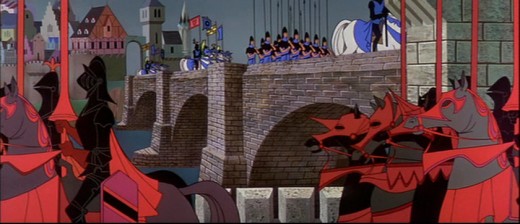
I don’t think it gets more artful than this.
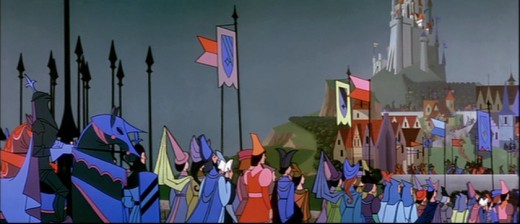
So what’s the answer? We’re in a hole; how do we get out?
It’s all about hope and hard work and not giving up finding that inspiration wherever you can.
A couple of years ago, I was about to throw in the towel. As usual, it was an incessant fight to keep my tiny company afloat. Just paying the rent was sapping my soul from any animation I could pick up. I wasn’t inspired by any of the films I was seeing, and I was beginning to lose hope.
Mike Barrier‘s book, Hollywood Cartoons, arrived just when I needed it, and I soaked it in. The book – especially the writing on Snow White – just charged me like no tomorrow. I finished reading it and started reading it again, immediately. That book saved me, no doubt, and I couldn’t have been more charged. Things turned around for me just by being excited by my medium.
You have to find the book or the film or the charge that’s going to keep you going. Writing this blog helps me, these days. In doing it, I’m always looking into films and frame grabs and endlessly studying animation I love. I can look past films that I think hurt the medium and find something that I love.
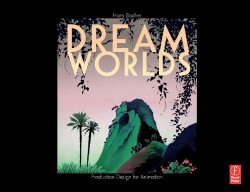 So many books such as Hans Bacher‘s Dream Worlds or Amid Amidi‘s Cartoon Modern offers lots of art; you have to find some inspiration. I’m looking forward to Sylvain Chomet‘s next film, The Illusionist. I want to see Clint Eastwood’s new film, The Changeling. Of course, I can always go to a museum in New York to find art that excites me. And live theater sometimes excites me.
So many books such as Hans Bacher‘s Dream Worlds or Amid Amidi‘s Cartoon Modern offers lots of art; you have to find some inspiration. I’m looking forward to Sylvain Chomet‘s next film, The Illusionist. I want to see Clint Eastwood’s new film, The Changeling. Of course, I can always go to a museum in New York to find art that excites me. And live theater sometimes excites me.
In short there are worlds out there, and I find it up to me to get that inspiration moving. I’ll probably focus on more of those books and films and artworks that inspire me, so this rant just ain’t going to end any time soon.
Sorry.
Commentary 26 Jun 2008 07:51 am
Conflict
- Something tells me this post will get a lot of people angry at me.
There was a bit of a conflict for me on Tuesday night in New York. Bill Plympton screened his film, Idiots and Angels, for much of the animation community here. While Wall-E played at the Academy at 6PM, Plympton’s film started at 4PM. It was a tough hustle to get from one to the other. What was more of a problem for me was having to leave work at 3PM to see Bill’s film. I couldn’t make it work, and I’m sorry I missed it.
I wasn’t as sold on Wall-E as every review I’d read to date. The film, to me, felt less like an animated film than a special effect film.
The story of Wall-E, for those of you who don’t know, is about a robot who has been left on earth (presumably for about 700 years) to try to gather the residue of the planet left behind by the humans. They’ve made earth inhospitable for their own survival. Wall-E is the robot left, with a companion roach, to gather the garbage and compact it into large piles of cubes. He eventually falls in love (robot love) with a more modern robot sent to earth to search for signs of vegetation. Wall-E finds a plant and gives it to her.
Humans have moved to a large spaceship and are treated much too well. They’ve all grown enormously fat not moving from their lounge chairs. The machines are in control, until one human takes charge with the help of Wall-E and brings people back to earth.
Watching the film, it was starting to get claustrophobic while they were on on earth, so I was glad to see them leave. Something had to advance the story. The new world on board the spaceship ends up with robots chasing other robots back and forth, up and down the large ship. It gets awfully tiring, quickly.
The technical abilities are high, and the film is done with the greatest professionalism. But they’re machines being animated, and I never felt close to them. The Iron Giant, from that film, was a hostile, war machine and was supposed to stay a machine, but I felt more for that character than I did for Wall-E or his cutely developed girlfriend, EVE.
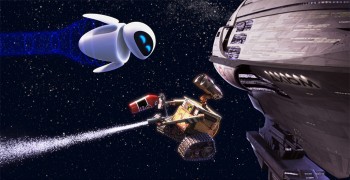 The film has a better concept than story. It’s the bane of all movies these days. If you can narrow the story down to one sentence, it’s more concept than story and has a harder time being successful. Wall-E feels a lot like Short Circuit 3 with no humans – for at least the first half.
The film has a better concept than story. It’s the bane of all movies these days. If you can narrow the story down to one sentence, it’s more concept than story and has a harder time being successful. Wall-E feels a lot like Short Circuit 3 with no humans – for at least the first half.
I was, again, impressed with the incredible artistic abilities of the Pixar people, but I didn’t feel as though I were watching an animated film. It felt like a live action film (until the balloony fat people entered) with high effects. Perhaps that’s a positive; I’m not sure anymore.
Pinocchio, Bambi, Dumbo, Snow White. These films were magic to me as a child. I imagine Wall-E is like every other effects film to today’s children. I can’t imagine it will inspire future generations to get into the field. Maybe, you never know.
I’m sorry I missed Idiots and Angels; I’m sure I’ll see it in Ottawa.
Today’s NY Post gives Wall-E a four star review which ends with, “Some day, there will be college courses devoted to this movie.” The Village Voice‘s glowing review says, “a film that’s both breathtakingly majestic and heartbreakingly intimate.” I can also understand their POV. See it for yourself.

- I wanted to remind those in the New York area that the animated films of Satoshi Kon will be playing at Lincoln Center’s Walter Reade Theater.
The complete retrospective starts tomorrow, Friday, and continues through next Tuesday. Go here to see my recent post including the schedule and other information.
I hope to meet Mr. Kon tomorrow and will report on that this Saturday.
